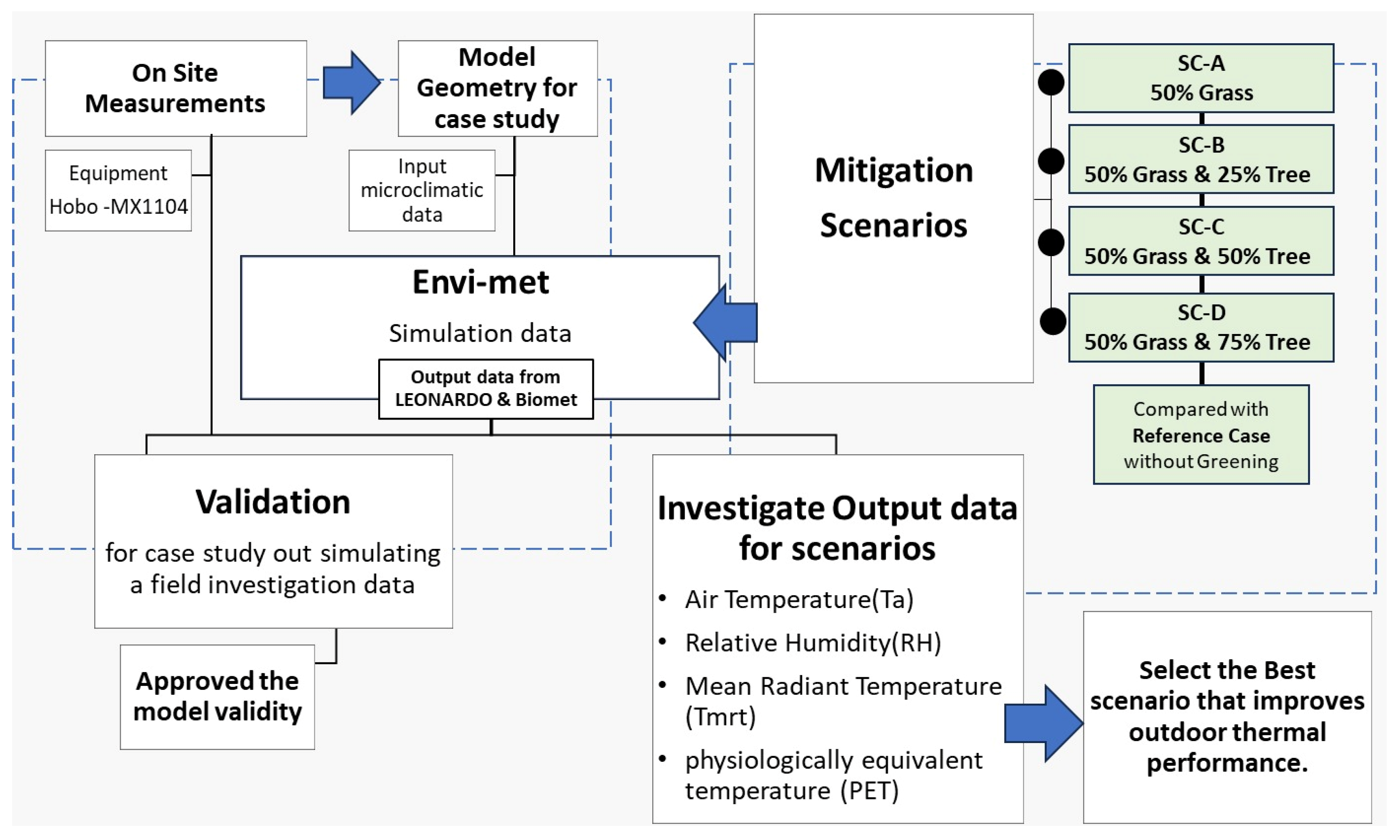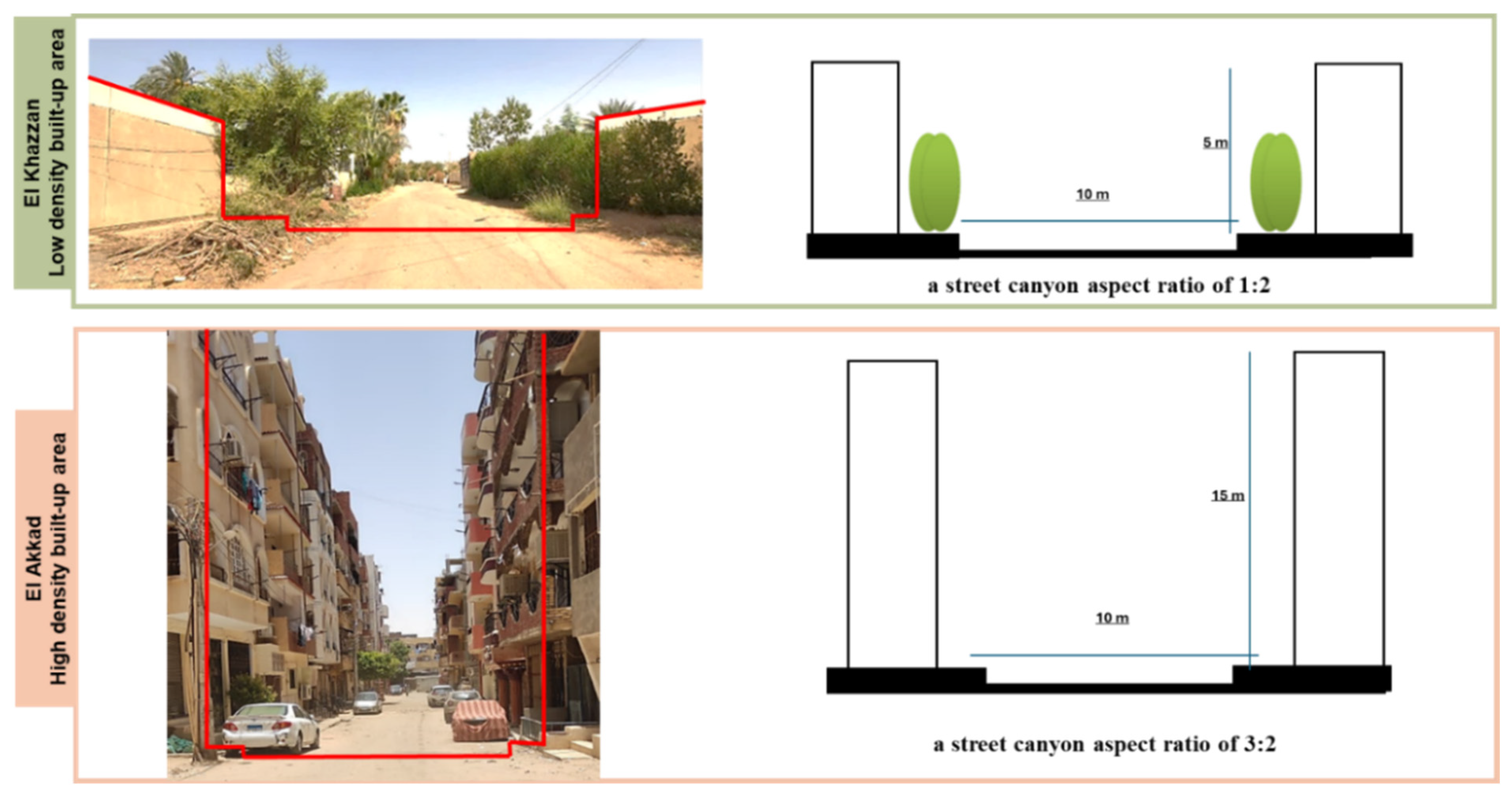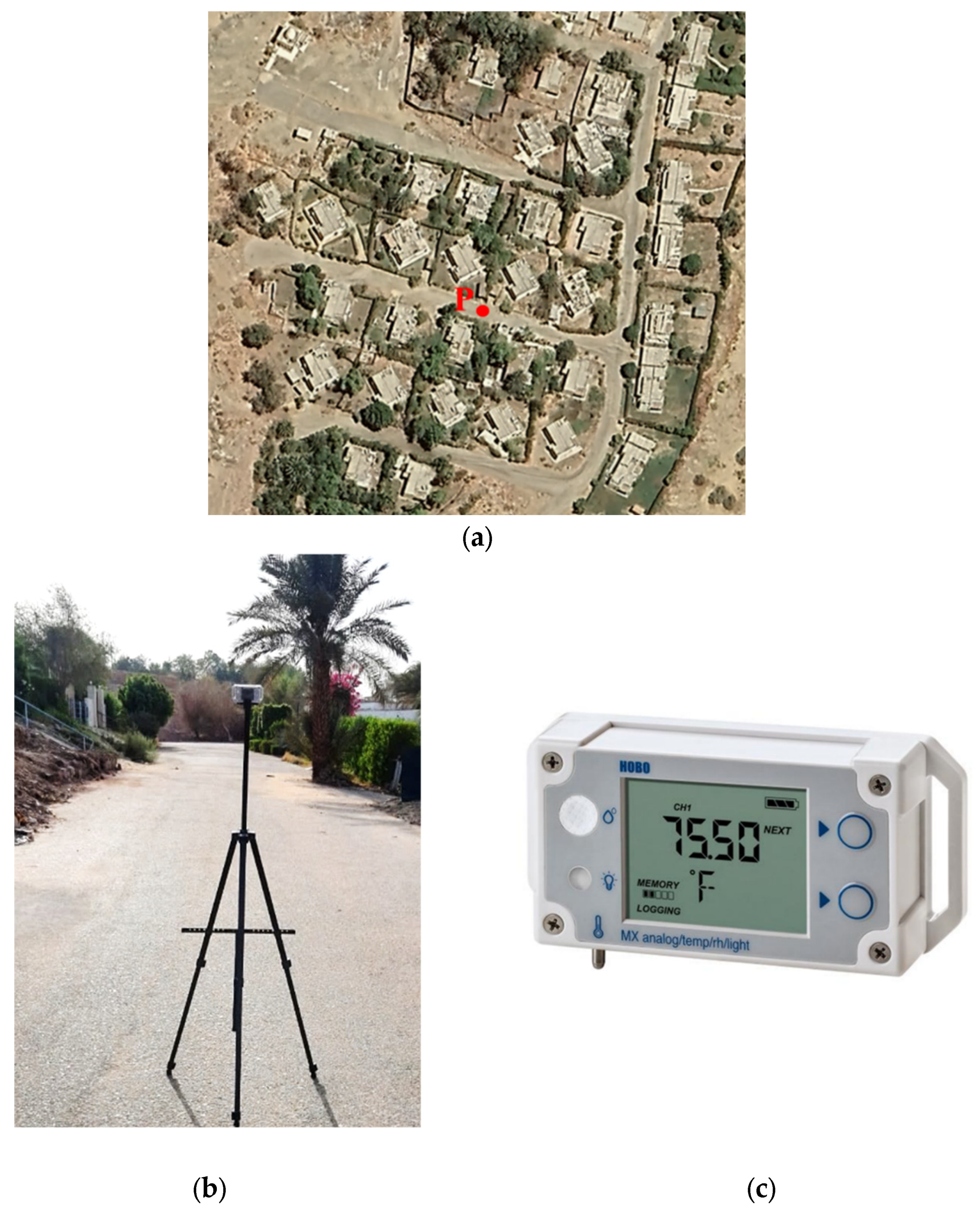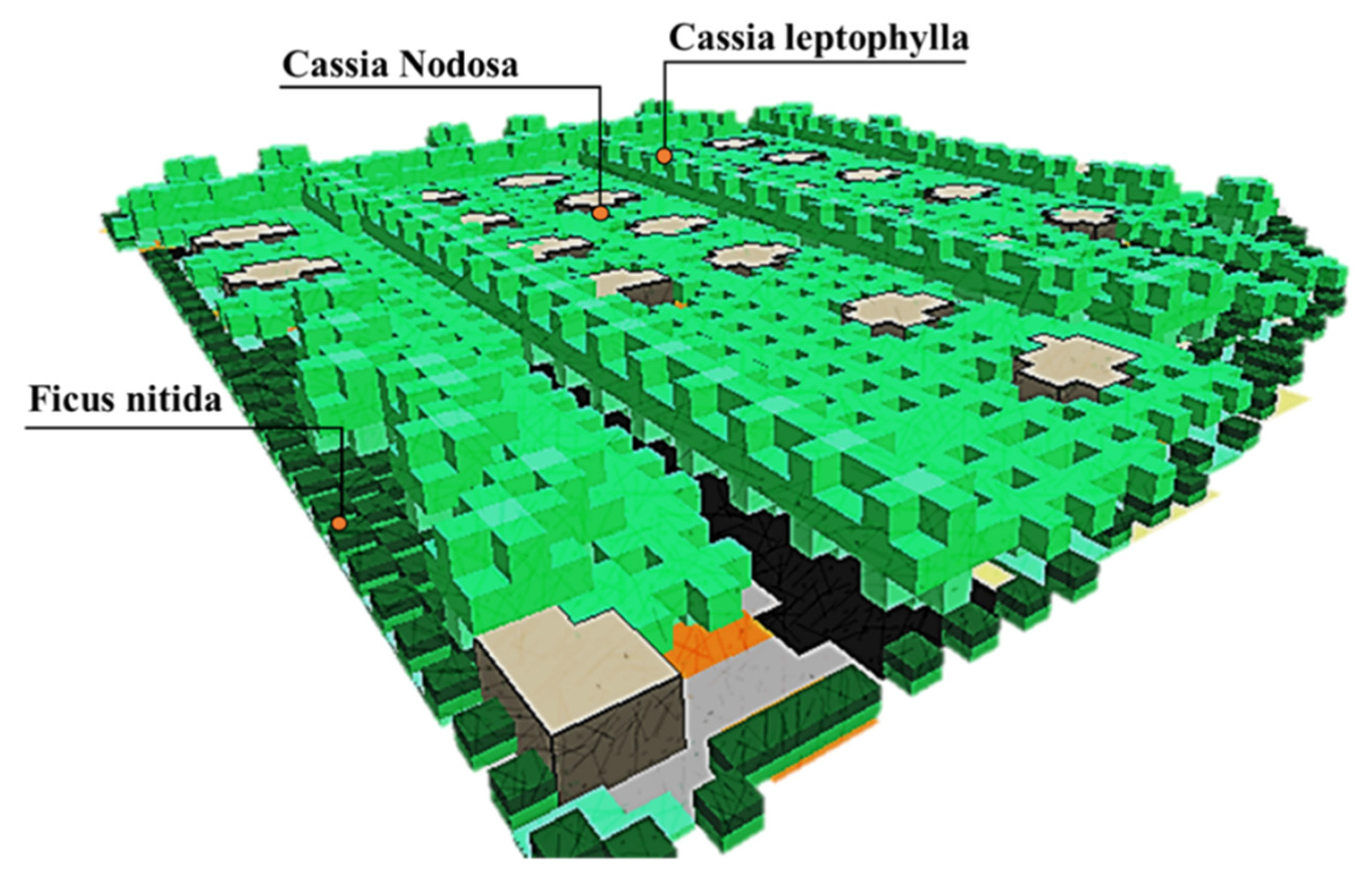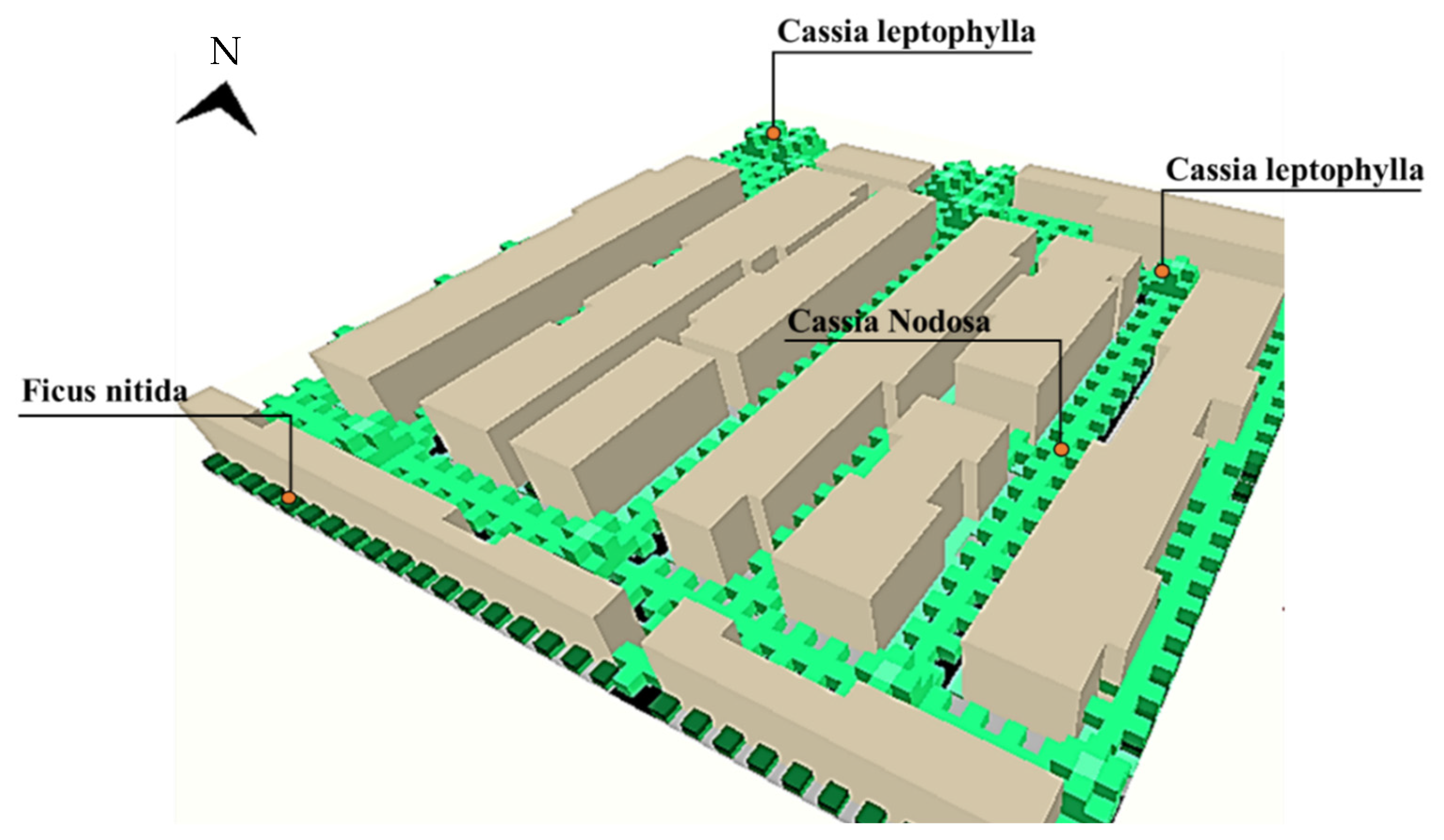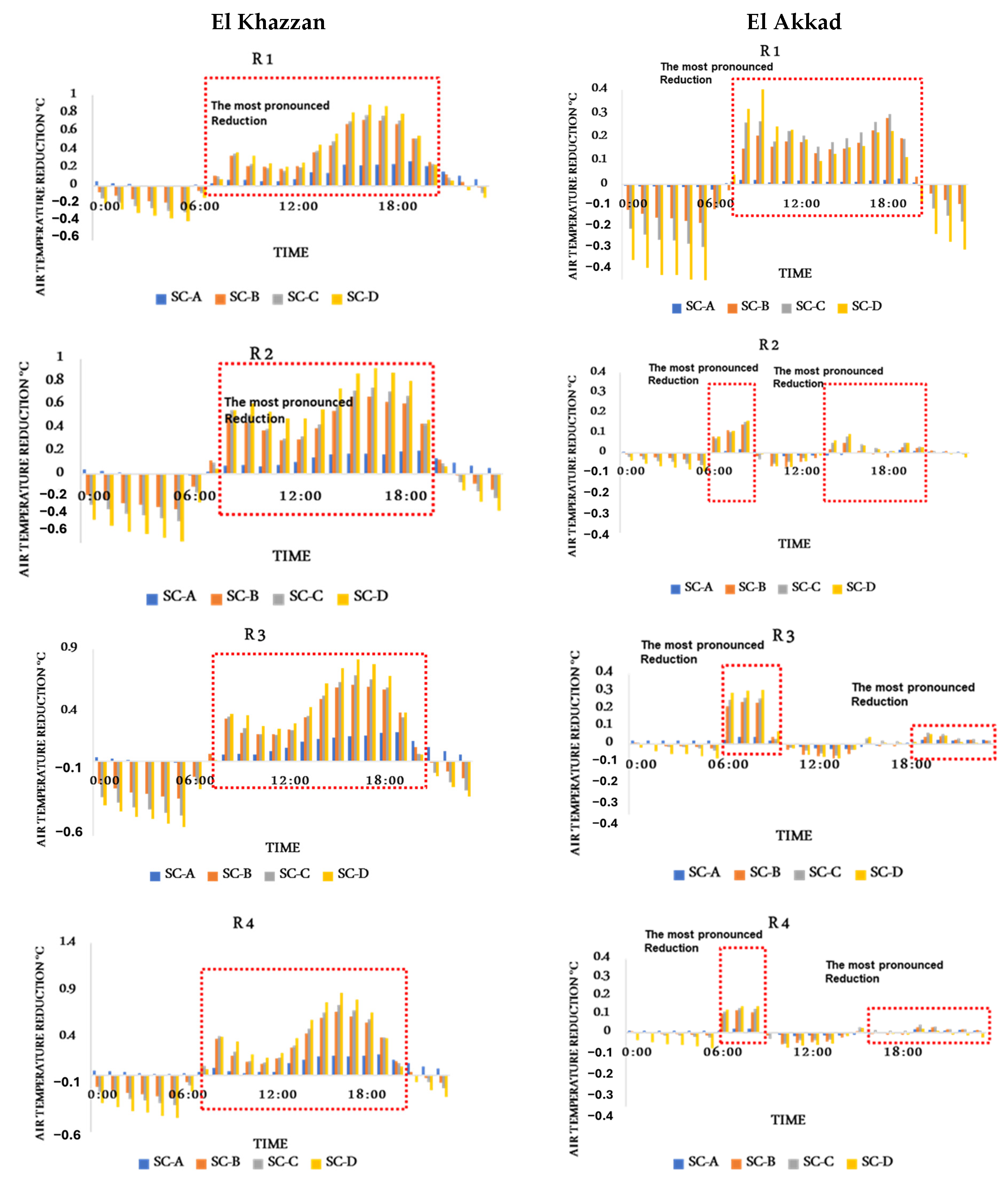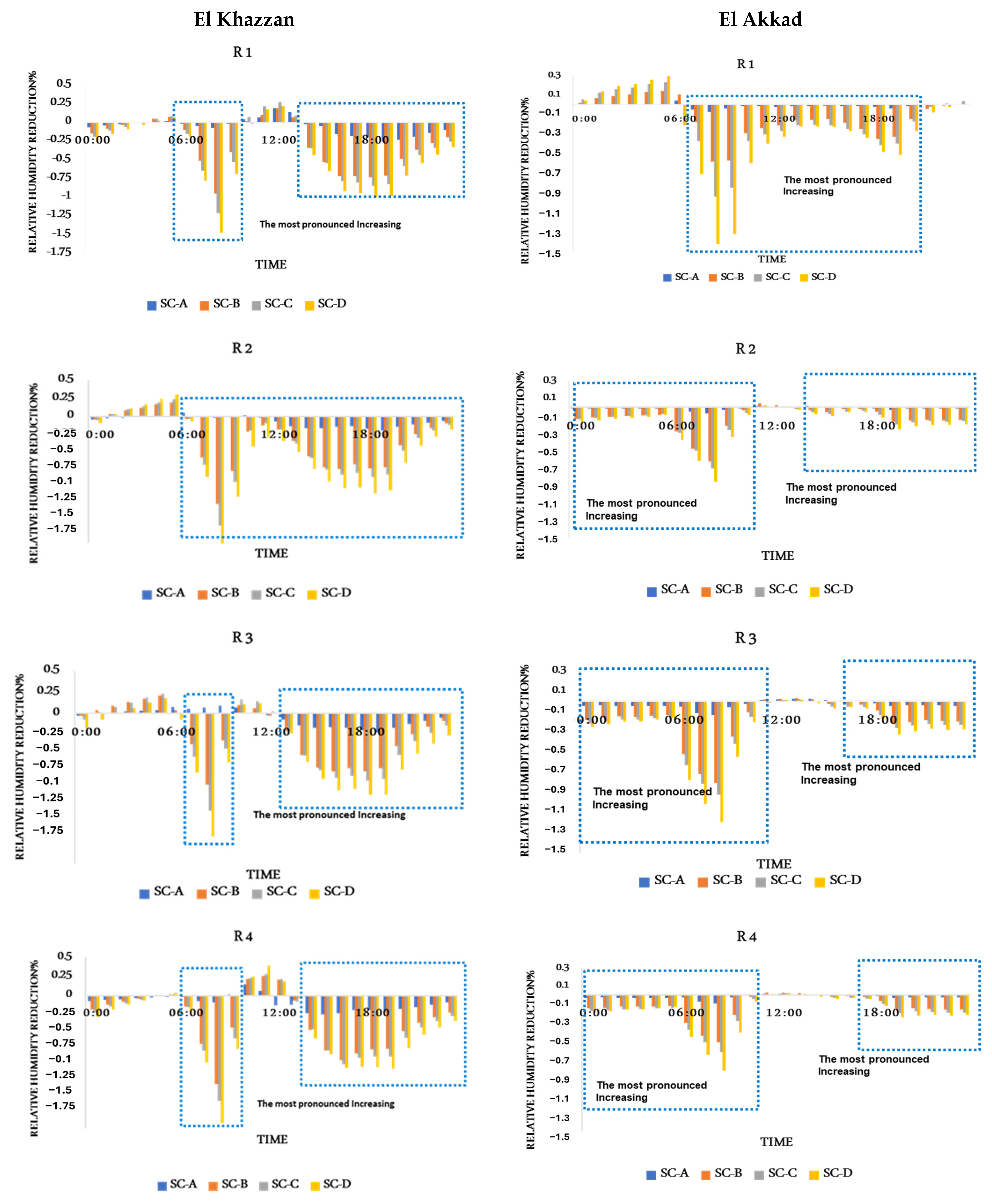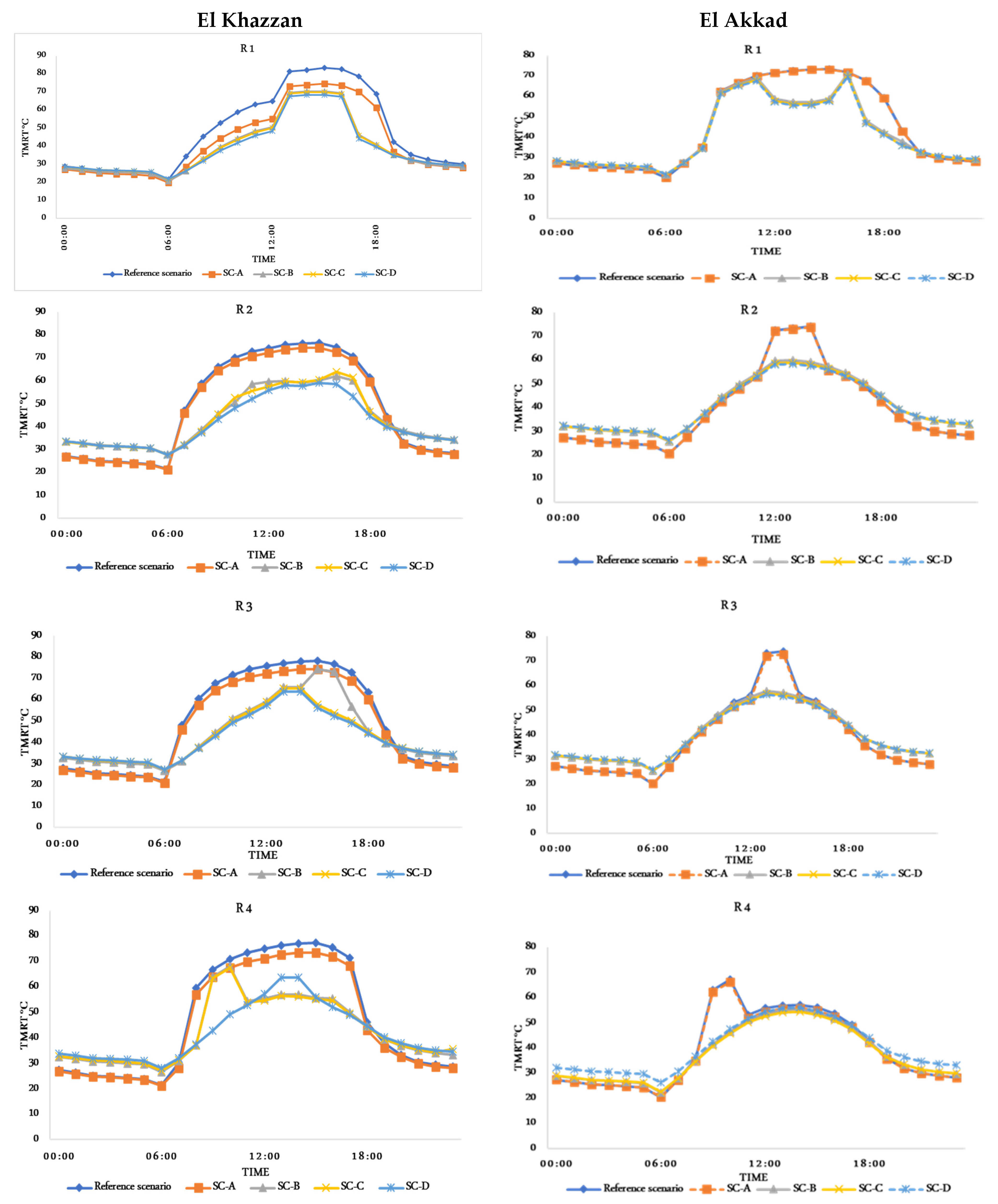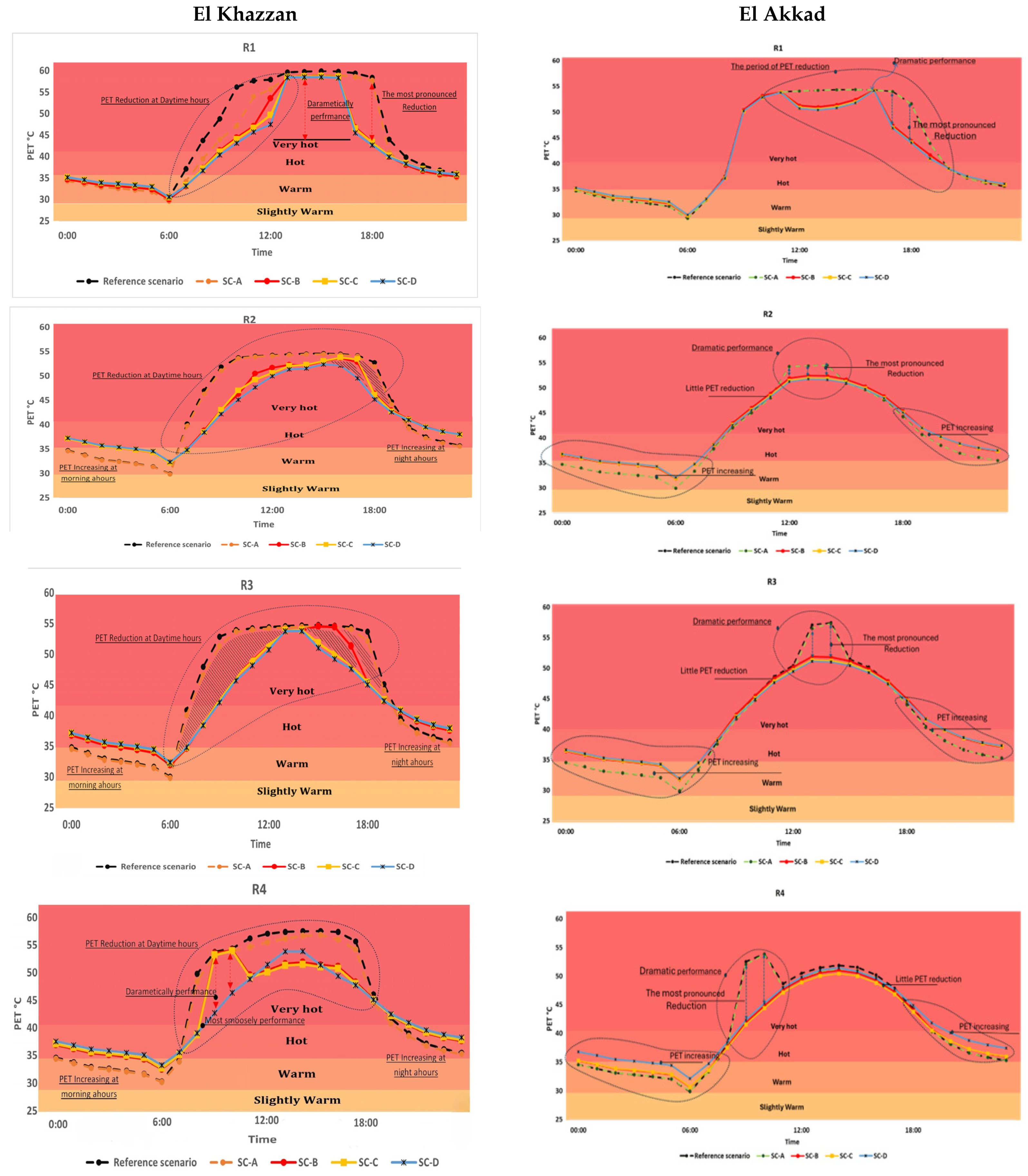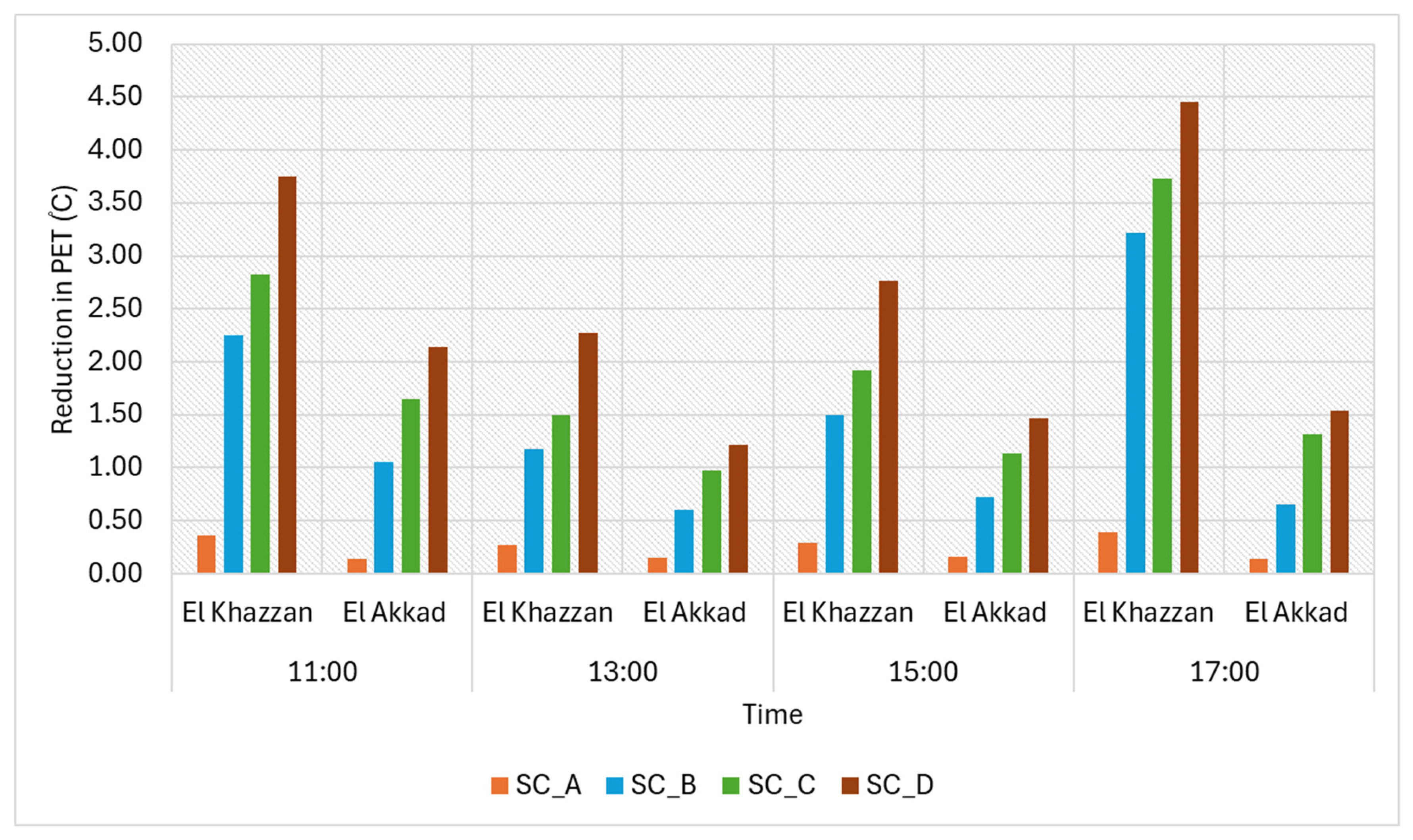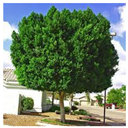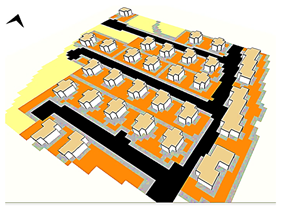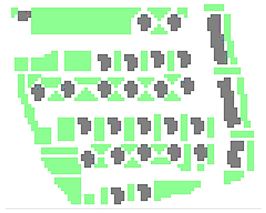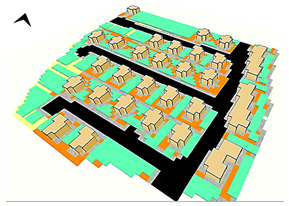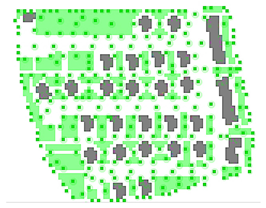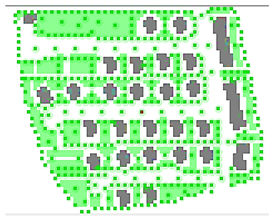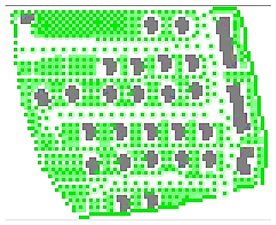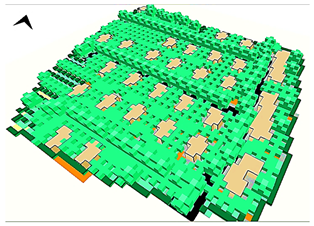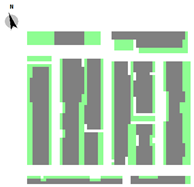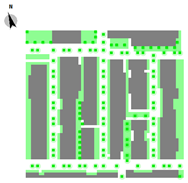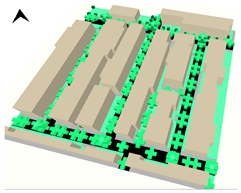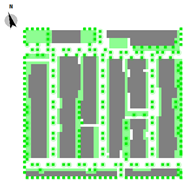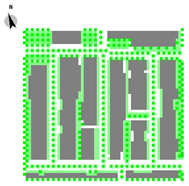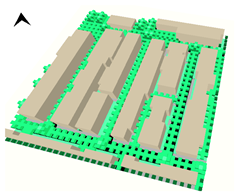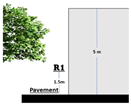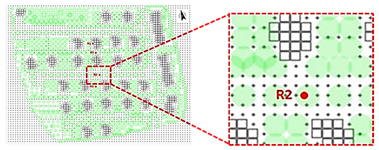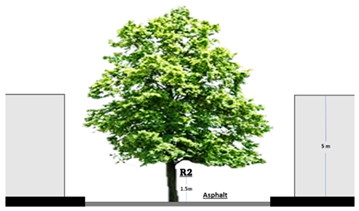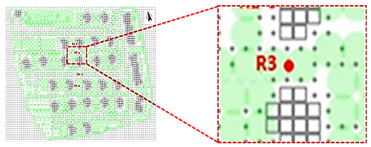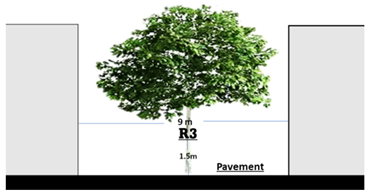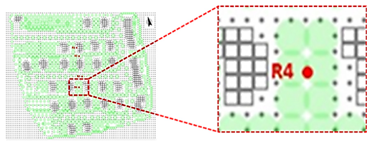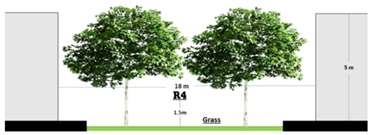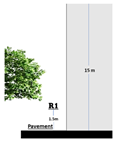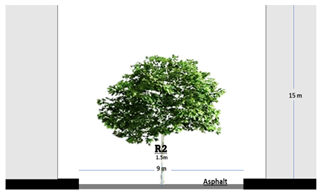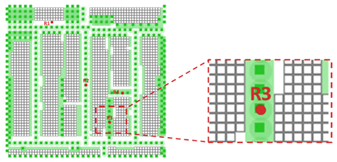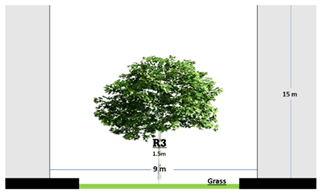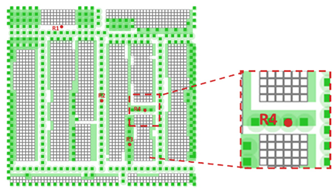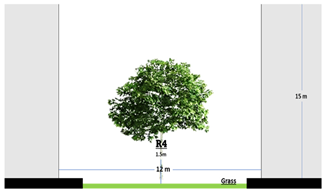1. Introduction
Cities worldwide are increasingly challenged by rising temperatures, urban overheating, and the intensification of extreme heat events driven by climate change and rapid urbanization. The urban heat island (UHI) phenomenon globally contributes to higher energy demand, public health risks, and reduced outdoor livability, with significant socioeconomic consequences in both developed and developing regions [
1,
2,
3]. Vegetation and nature-based solutions have been widely recognized as effective strategies to counteract these impacts by providing shade, enhancing evaporative cooling, and reducing radiant heat loads. Yet, their effectiveness is highly dependent on local climate and urban morphology. Hot–arid cities face intensified challenges due to scarce rainfall, intense solar radiation, and limited natural vegetation, making them critical testbeds for investigating urban greening strategies that are both climatically effective and resource-efficient.
Rapid urbanization and global warming have intensified heat stress in cities, particularly in hot and arid regions such as Aswan, Egypt. Rising air temperatures in these climates adversely affect outdoor thermal comfort, posing risks to public health, reducing pedestrian activity, and exacerbating the urban heat island (UHI) phenomenon [
4,
5]. UHI occurs when urban surfaces—such as asphalt, concrete, and other heat-retaining materials—absorb and store solar radiation, elevating ambient air temperatures compared to surrounding rural areas [
6]. Replacing natural vegetation with impermeable, low-albedo surfaces diminishes evaporative cooling and shading, amplifying heat stress in outdoor environments [
7,
8,
9]. This effect is further compounded in dense urban settings by limited airflow, heat storage in building materials, and the geometry of streets and public spaces [
10,
11,
12]. Urban heat stress is intensifying worldwide and is especially acute in hot, arid cities where high solar loads, scarce rainfall, and extensive impervious cover combine to elevate radiant and air temperatures and degrade outdoor thermal comfort. In Upper Egypt, including Aswan, recent work confirms that morphology, surface materials, and a deficit of shade amplify local heat exposure, underscoring the need for design-level mitigation that performs under severe boundary conditions [
13].
Urban vegetation—particularly trees and grass—has been widely recognized as an effective passive cooling strategy that mitigates UHI impacts by providing shade, enhancing evapotranspiration, and reducing mean radiant temperature (T
mrt) [
14,
15,
16,
17]. Numerous studies in hot and arid zones have examined the role of green infrastructure in microclimate regulation. For instance, Shashua-Bar et al. [
18] demonstrated that combining shade trees with grass yields the greatest midday reduction in thermal stress, balancing water efficiency and cooling effectiveness. In Algeria’s Sahara region, Dohssi et al. [
19] vegetation significantly moderated microclimatic conditions, improving physiological responses and perceived comfort. Similarly, studies in tropical and subtropical climates have shown that the density, arrangement, and species of trees influence cooling outcomes, with higher canopy coverage generally producing more substantial reductions in PET and T
mrt [
20,
21,
22].
A recent large-scale meta-analysis by Li et al. [
23] confirmed that cooling efficacy varies significantly depending on background climate, urban morphology, and tree traits. In hot–arid climates, high solar exposure and low humidity can amplify the daytime cooling benefits of trees, while nighttime responses depend strongly on canopy density and sky view factor. This reinforces the need for climate-specific vegetation strategies rather than a one-size-fits-all approach. Several recent hot–arid case studies provide direct regional insights. Gomaa et al. [
13] examined courtyard vegetation in Aswan using ENVI-met simulations validated by field measurements and found that ~60% canopy coverage by Cassia nodosa reduced PET by over 25 °C and T
mrt by over 31 °C. In Cairo, Abdelmejeed and Gruehn [
24] optimized an urban tree strategy considering water scarcity and demonstrated that well-positioned canopy trees in dense urban canyons reduced afternoon PET by 5–6 K, mainly through shading-driven T
mrt reduction.
Beyond individual cases, recent ENVI-met developments have improved vegetation representation and substrate interactions. Ahmed et al. [
25] applied ENVI-met to historic public spaces in Rome, showing that targeted tree and grass interventions can reduce UHI intensity while preserving visual heritage. Eingrüber et al. [
26] parameterized grass grid pavers in ENVI-met v5, finding that combining permeable vegetated surfaces with shading reduced surface temperatures by up to 20.1 K and pedestrian-level air temperatures by up to 7.1 K during heatwaves. Yan et al. [
27] and Qin and Zhou [
28] further demonstrated that the spatial arrangement of vegetation in parks and courtyards can create substantial microclimatic heterogeneity, with optimal configurations varying seasonally. However, cooling effectiveness is not uniform; it varies with urban morphology, building density, and the interaction between vegetation and local airflow patterns [
29,
30]. In compact high-density urban canyons, tall buildings may provide shading benefits that partially reduce peak PET values [
31,
32,
33,
34]. Still, dense tree planting can sometimes obstruct ventilation, leading to localized heat retention during nighttime hours [
30]. Conversely, in low-density environments, open layouts maximize the benefits of tree shading and evapotranspiration, producing more consistent cooling throughout the day [
35,
36].
While previous research has explored vegetation-based mitigation in various climates, systematic cross-density comparisons in hot–arid environments remain underexplored. Most studies have examined a single urban morphology—compact canyons, courtyards, or low-density residential layouts—without directly comparing how vegetation functions across contrasting built forms under the same climatic conditions. This limits our understanding of whether vegetation strategies optimized for one density can be generalized to others. Such comparative assessments are particularly relevant in hot–arid cities, where rapid urban growth produces diverse morphologies that coexist within the same metropolitan area. This gap is critical in Upper Egypt, particularly in Aswan, given the extreme climatic severity and the sharp morphological contrasts between districts. Recent advances in ENVI-met vegetation modeling and local empirical studies have not yet been applied to this issue. This underscores the need for cross-density, multi-scenario analyses to provide context-specific guidance for planners and designers.
Accordingly, this study evaluates the cooling potential of various vegetation scenarios in Aswan’s residential districts with different built-up densities. Using the ENVI-met microclimate simulation model, four vegetation configurations—ranging from grass-only to combinations with varying tree cover—are assessed regarding their impact on key microclimatic parameters, including Ta, Tmrt, RH, and PET. The findings contribute to the global discourse on urban heat mitigation by providing evidence-based guidelines for optimizing vegetation strategies in hot–arid environments and addressing the underexplored question of how vegetation performance differs across contrasting urban densities.
2. Materials and Methods
The study employed a rigorous, multi-stage methodology to investigate the thermal performance of urban vegetation, using a combination of on-site data collection and computational modeling. The first stage involved validating the ENVI-met microclimate model against real-world measurements from two distinct urban districts: the low-density El Khazzan and the high-density El Akkad (
Figure 1). This validation ensured the model’s outputs for air temperature (T
a) and relative humidity (RH) accurately reflected reality, as confirmed by low Root Mean Square Error (RMSE) values and high coefficients of determination (R
2). Following validation, the methodology’s core focus was a comparative analysis of five simulation scenarios within each district. A baseline reference case with no vegetation was established, and four mitigation scenarios were created with a constant 50% grass coverage and incrementally increasing tree densities (0%, 25%, 50%, and 75%).
For each scenario, detailed data was systematically collected from four strategically positioned points representing different urban micro-environments. The analysis quantified the effects of vegetation on key thermal indicators, including Ta, RH, Tmrt, and PET. This approach directly compared the mitigation strategies’ effectiveness across the two contrasting urban morphologies. To provide a holistic view, the study also generated and analyzed thermal distribution maps for both districts, synthesizing the point-based numerical results into a comprehensive understanding of the urban thermal landscape. This structured framework ensured the research provided robust, quantifiable evidence on how urban form dictates the success of vegetation-based climate strategies.
2.1. Study Area and the Case Studies
This study focuses on two residential districts in Aswan, Egypt, each representing a distinct built-up density. Aswan is located in the southern region of Egypt (
Figure 2) [
37]. The selected cases include El Khazzan, a low-density residential district, and El Akkad, a high-density residential district. The analysis investigates potential heat mitigation scenarios achievable through integrating vegetation into each district’s urban fabric.
El Khazzan and El Akkad districts (
Figure 3) exhibit contrasting urban morphologies, offering an opportunity to investigate how urban form and vegetation characteristics impact outdoor thermal comfort in arid environments. El Khazzan is a low-density residential zone with a total area of 33,800 m
2. It is located approximately 9 km south of Aswan Airport. As shown in
Table 1, the land-use ratio indicates that only 13% of this area is built up, with the remainder comprising open spaces and vegetation. These percentages were calculated through GIS-based analysis of high-resolution satellite imagery (Google Earth Pro, August 2023) and cadastral maps obtained from the General Organization of Physical Planning (GOPP) in Egypt for Aswan City. The digitized data was further verified through on-site surveys conducted by the research team. The built environment consists primarily of single-story, load-bearing wall residential buildings with an average footprint of 130 m
2. The street network follows an aspect ratio of 1:2, with 10 m-wide streets bordered by buildings 5 m in height (
Figure 4). Each residential block contains a green yard, contributing to the overall vegetation cover and offering potential for passive cooling through shading and evapotranspiration. These attributes make El Khazzan a representative case for assessing the role of vegetation in improving thermal comfort in low-density, hot, and arid settings.
El Akkad is a high-density residential district with the same total area (33,800 m
2) but a markedly different urban structure. As indicated in
Table 1, approximately 70% of the area is built up and composed of multi-story apartment buildings of similar architectural design. Each building includes a ground floor and four additional floors, giving a total height of 15 m. The compact urban form creates narrow street canyons with limited green space, contrasting with El Khazzan. This morphological difference makes El Akkad an appropriate counterpart for evaluating how varying urban densities influence outdoor thermal comfort under the same climatic conditions. By comparing these two districts, the study aims to provide insight into how urban design and vegetation configurations can be optimized for thermal comfort in hot, arid climates.
2.2. On-Site Measurement
An extensive on-site measurement campaign was undertaken in both the El Khazzan and El Akkad districts to establish a reliable baseline for assessing the thermal performance of the selected study areas. The collected field data was a critical reference for validating the ENVI-met simulation model. Measurements of key environmental variables, namely T
a and RH, were conducted continuously over 24 h on 13 August, a date selected to represent typical peak summer conditions in Aswan. These conditions are characterized by intense solar radiation and high ambient temperatures, making them ideal for evaluating extreme microclimatic scenarios [
36]. The data was recorded at hourly intervals using Onset HOBO MX1104 data loggers, which were positioned at a height of 1.5 m above ground level. This height was deliberately selected to represent the pedestrian’s breathing zone and the thermal environment experienced by people outdoors. Although the World Meteorological Organization (WMO) recommends a 2 m reference height for standard meteorological observations, the 1.5 m level is widely adopted in outdoor thermal comfort studies [
15,
29] to capture human-relevant microclimatic conditions and to support indices such as PET and T
mrt. (
Figure 5). This setup ensured that the recorded values reflected realistic human exposure to the outdoor environment. The resulting dataset provided a robust and context-specific foundation for subsequent analysis and model calibration.
2.3. Model Setup and Simulation Conditions
The ENVI-met model was configured with a grid dimension of 100 × 100 × 30 grids, with a grid size of dx = 3.00 m, dy = 3.00 m, and a base dz = 3.00 m. The core XY domain size was set to x = 300 m and y = 300 m. Soil profiles and floor albedo values were parameterized based on the specific urban materials of the study areas (e.g., sandy soil, loamy soil, pavement, and asphalt). The simulation was performed over 24 h on August 13th, a date selected to represent a typical hot summer day in Aswan. This period is characterized by intense solar radiation and extreme thermal stress, making it suitable for evaluating outdoor thermal comfort and mitigation strategies. The resulting dataset comprised 24 hourly values of Ta and RH for 13 August, which were later used to validate the ENVI-met model outputs for the same day. Surface albedo and thermal properties of pavements, tiles, and building envelopes were parameterized for each district based on on-site observations and local material data to ensure realistic surface radiation behavior in the simulations.
2.4. Model Validation
The reliability of the ENVI-met model was confirmed through a rigorous validation process that compared its simulated outputs with real-world, on-site data collected in both the El Khazzan and El Akkad districts. Measurements were taken continuously over 24 h (13 August), yielding T
a and RH hourly values. These were directly compared with the hourly ENVI-met simulation outputs for the same day to perform the validation. The model’s validity was confirmed using the root mean square error (RMSE) and the coefficient of determination (R
2). The model’s validity was confirmed using the root mean square error (RMSE) and the coefficient of determination (R
2), both calculated from hourly values of Ta and RH across the full 24 h monitoring period (13 August). 95% confidence intervals (CIs) were calculated for both measured and simulated data to provide stronger statistical reliability. These CIs demonstrate that the ENVI-met simulations consistently fall within the variability bounds of the field observations, underscoring the robustness of the model calibration. For the El Khazzan district, the model demonstrated high accuracy. The low RMSE values for air temperature (2.44%) and relative humidity (2.24%) fell well within the ±20% tolerance threshold set by ASHRAE, a widely accepted standard for building energy and environmental performance. Furthermore, high R
2 values (0.84 for air temperature and 0.86 for relative humidity) further demonstrated a strong correlation between the simulated and measured data, affirming the model’s reliability for this study (
Figure 6).
The validation process was similarly conducted for the El Akkad district to ensure the model’s performance was consistent across different urban morphologies. The simulated air temperature (Ta) data for El Akkad demonstrated a strong correlation with the measured on-site data. The model successfully captured the diurnal trend of air temperature, with its accuracy quantitatively confirmed by a Root Mean Square Error (RMSE) of 0.82 K. This low error indicates a high degree of precision. It validates the model’s capability to predict air temperature with a high confidence level for this urban morphology. Similarly, the relative humidity (RH) validation showed good agreement between the simulated and measured data. The model effectively replicated the inverse relationship between RH and temperature throughout the day. The RMSE for relative humidity was calculated at 2.5%, confirming the model’s reliability in representing the thermo-hygrometric conditions of the El Akkad district (
Figure 7).
All simulations were conducted 24 h on 13 August, a representative summer day, using hourly meteorological input. This day was selected to capture extreme hot-season conditions in Aswan.
2.5. Tree Species, and Proposed Scenarios
The proposed scenarios were designed to systematically quantify the impact of greening on these distinct urban forms, referencing the findings of previous studies [
13,
24,
38]. Three distinct types of urban trees were selected for this study—Cassia leptophylla, Cassia nodosa, and Ficus nitida—based on their prevalence and performance in hot-arid environments. These species are commonly used in Aswan and similar regions due to their resilience to high solar loads, drought tolerance, and capacity to enhance microclimatic cooling through shading and evapotranspiration. Ficus nitida, with its dense canopy, is widely planted along urban boundaries and streetscapes for shading and microclimate regulation [
24]. Cassia nodosa and Cassia leptophylla were selected for their moderate canopy density, ornamental integration in residential landscapes, and favorable Leaf Area Index (LAI), defined as the ratio of total one-sided leaf surface area to the ground surface area beneath the canopy. LAI is a critical parameter that characterizes canopy density and directly influences radiation interception, evapotranspiration, and shading efficiency [
23]. By selecting species with varying LAI values, the study ensured representation of different canopy structures, thereby enabling a comparative assessment of shading and evapotranspiration efficiency in contrasting urban morphologies.
The three selected species differ in their canopy density as expressed by their LAI values. Ficus nitida typically exhibits a high LAI of ~4.5–5.0, reflecting its dense canopy and strong shading potential. Cassia nodosa has a moderate LAI of ~2.5–3.0, providing partial shading while allowing some airflow, whereas Cassia leptophylla has a slightly higher LAI of ~3.5–4.0, offering a balance between shading and evapotranspiration [
18,
23]. These variations in LAI were considered in the ENVI-met input parameters and are critical for comparing the effectiveness of tree species in different urban morphologies.
The results of this foundational work indicated that trees with denser foliage and higher radiation reflectivity exhibited increased cooling effects through evapotranspiration, radiation reflection, absorption, and shading. The chosen species, Cassia leptophylla, Cassia nodosa, and Ficus nitida, were strategically applied based on their characteristics [
38]. Specifically, Ficus nitida was used at the urban site boundaries to provide shading and enhance air circulation, while Cassia leptophylla and Cassia nodosa were placed within the urban form. The specifications of these trees are detailed in
Table 2 as derived from earlier studies [
13,
24,
38].
To achieve this, four specific scenarios were simulated for each district, as well as a no-vegetation reference case. The core design criterion maintained a constant 50% grass coverage of the outdoor area while increasing tree coverage. The scenarios were as follows:
- ▪
Scenario A (Sc-A): 50% grass, no trees.
- ▪
Scenario B (Sc-B): 50% grass, 25% trees.
- ▪
Scenario C (Sc-C): 50% grass, 50% trees.
- ▪
Scenario D (Sc-D): 50% grass, 75% trees.
This graduated approach enabled a detailed analysis of how increasing tree canopy density contributes to cooling and shading effects and how it interacts with the base layer of grass to influence thermal comfort.
Figure 8 and
Figure 9 illustrate the distribution of the tree types for the El Khazzan and El Akkad districts, respectively.
2.6. Mitigation Scenarios Based on Vegetation Strategies
Using the Envi-met software, this study evaluated the thermal performance of different urban vegetation strategies using key indicators like Ta, RH, T
mrt, and PMV. The investigation focused on four specific points within each simulated scenario to assess the district’s thermal conditions. The data were then compared to a reference case with no vegetation (
Table 3 for El Khazzan;
Table 4 for El Akkad). The vegetation scenarios were designed to leverage the trees’ cooling and shading properties and the grass’s reflective qualities to mitigate heat buildup and improve thermal comfort. These scenarios were structured into four distinct vegetation percentages for two case studies, El Khazzan and El Akkad. The proposed scenarios included a gradual increase in tree cover from 25% to 75%, while the grass coverage was kept constant at 50% of the total outdoor area.
The analysis focused on four representative measurement points (R1–R4), which were strategically selected to capture the diversity of microclimatic conditions within the study areas. These points reflect variations in shading intensity, surface materials, and urban geometry, providing a comprehensive basis for evaluating thermal comfort performance.
Table 5 and
Table 6 summarize these points’ detailed locations and descriptions in the El Khazzan and El Akkad districts.
R1 is positioned on a paved surface adjacent to a residential building, where the combination of built form and hardscape materials creates a distinct thermal environment. R2 is located on an asphalt-covered street; in El Khazzan, this point is shaded by Leptophylla trees, while in El Akkad it is shaded by Cassia nodosa trees, allowing for a comparative assessment of species-specific canopy performance. R3 lies within a setback area of a residential building, also on a paved surface, and benefits from the shade of a Cassia nodosa tree. Finally, R4 is situated in a buffer zone characterized by open, unobstructed space with grass cover, supplemented by the shade of Leptophylla trees. These points capture a spectrum of microclimatic conditions, highlighting the interaction between vegetation, surface materials, and urban morphology.
3. Results
3.1. Air Temperature (Ta)
Mitigation strategies using vegetation consistently improved air temperature (Ta) in the El Khazzan and El Akkad districts. However, the degree of improvement varied significantly due to differences in urban density. The impacts of these strategies were evaluated across four measurement points: R1, R2, R3, and R4. In the lower-density El Khazzan district, vegetation led to a significant daytime temperature reduction between 8:00 a.m. and 7:00 p.m. Scenario D (Sc-D), with the highest tree density (75%), produced the most substantial cooling effect, with a temperature drop ranging from 0.2 K to 0.92 K. However, a complex interaction was observed at night (8:00 p.m. to 5:00 a.m.). While Scenario A (Sc-A), which featured only grass, maintained a modest temperature reduction of 0.2 K, scenarios with a high density of trees (Sc-C and Sc-D) surprisingly led to temperature increases. This is likely because the dense tree canopy disrupts natural airflow, trapping heat and preventing effective nocturnal cooling. The higher-density El Akkad district showed a similar, but less pronounced, pattern. Daytime temperature reductions were more modest, with Sc-D decreasing 0.1 K to 0.4 K. The nighttime warming effect was also more pronounced here; Sc-B, Sc-C, and Sc-D all recorded temperature increases ranging from 0.01 K to 0.4 K. Sc-A remained stable and showed no temperature increase at night. These findings suggest that high urban density can limit the cooling benefits of vegetation, particularly at night, by impeding airflow and exacerbating heat retention. Overall, El Khazzan’s lower density allowed for more effective daytime cooling and more stable nighttime temperatures compared to the more challenging conditions in El Akkad.
Figure 10 shows the effects of the investigated scenarios on the air temperature in both El Khazzan and El Akkad districts.
It is worth noting that the maximum cooling effect recorded in the vegetation scenarios was less than 1 K. This relatively modest reduction can be attributed to the extreme background temperatures and high solar radiation levels in Aswan, which limit the cooling capacity of vegetation at the microscale. Furthermore, the tested scenarios were constrained to feasible tree planting densities within existing urban morphologies, rather than extensive greening interventions. Previous studies in hot–arid climates report similar magnitudes of air temperature reduction, typically less than 1 K, while highlighting that vegetation produces more substantial improvements in T
mrt and PET due to shading effects [
18,
24]. Thus, even modest cooling at the air temperature level can translate into significant comfort benefits when considering radiation and humidity.
3.2. Relative Humidity (RH)
Implementing vegetation-based mitigation scenarios resulted in a modest but consistent relative humidity (RH) increase across all measurement points in the low-density El Khazzan and high-density El Akkad districts.
Figure 11 provides a visual representation of these changes. In El Khazzan, the increase in RH was directly proportional to the amount of vegetation. During the daytime (7:00 a.m. to 7:00 p.m.), Sc-A saw an average RH increase of 0.018% to 0.263%, while Sc-B, Sc-C, and Sc-D showed progressively higher increases, with Sc-D peaking at a range of 0.4% to 1.5%. The nighttime RH remained elevated in tree-inclusive scenarios (Sc-C and Sc-D), with increases ranging from 0.1% to 0.7%. Sc-A maintained a consistent 0.1% increase throughout the night.
The El Akkad district followed a similar trend, but with lower overall increases. Daytime RH increases were modest, with Sc-D showing the highest growth from 0.005% to 1.44%. An interesting anomaly was observed in the early morning (12:00 a.m. to 6:00 a.m.) at point R1, where tree-inclusive scenarios (Sc-B, Sc-C, and Sc-D) caused a slight decrease in RH (0.1% to 0.3%). This suggests a complex microclimatic interaction that localized conditions could influence. Trees enhance RH through evapotranspiration, which releases water vapor into the air. The shade provided by tree canopies also reduces surface and air temperatures, which, in turn, slows down evaporation from the ground and further contributes to higher RH. The lower density in El Khazzan allowed for a more significant impact from vegetation, creating a more comfortable microclimate with higher humidity and lower temperatures. In contrast, El Akkad’s high density limited the effectiveness of vegetation, leading to a less pronounced increase in RH and potentially contributing to thermal discomfort during the night.
Figure 11 presents the effects of the investigated scenarios on the relative humidity in both El Khazzan and El Akkad districts.
3.3. Mean Radiant Temperature (Tmrt)
Mean Radiant Temperature (T
mrt) is the uniform temperature of an imaginary enclosure. The radiant heat exchange between the human body and its environment would equal the radiant heat exchange in the actual non-uniform climate. It integrates the combined effects of shortwave (solar) and longwave (infrared) radiation from surrounding surfaces and the sky [
39,
40]. T
mrt is one of the most influential parameters affecting outdoor human thermal comfort, as it directly determines the radiant load on the body and is a critical input for thermal indices such as Physiologically Equivalent Temperature (PET).
Tmrt study revealed significant thermal performance differences between the two districts and across different mitigation scenarios. The results consistently show that the low-density El Khazzan district benefited more from vegetation-based strategies than the high-density El Akkad district. At R1 (pavement tile near a residential building), El Khazzan’s reference scenario peaked at 83.3 °C, while El Akkad’s was lower at 73.2 °C, likely due to the higher building density providing more shading. All mitigation scenarios significantly improved conditions in both districts. In El Khazzan, Sc-D achieved the highest Tmrt reduction of 17.4 °C on average, with a peak reduction of up to 34 °C at 5:00 p.m. In El Akkad, reductions were less substantial, with Sc-D achieving an average reduction of 10 °C. A key finding was the nighttime performance: tree-inclusive scenarios slightly increased Tmrt at night in both districts. At the same time, the grass-only Sc-A provided the most stable thermal performance during these hours.
At R2 (asphalt surface with tree shade), the influence of urban density was even more apparent. In El Khazzan, tree-inclusive scenarios (Sc-B, Sc-C, and Sc-D) provided significant daytime reductions, with Sc-D reducing T
mrt by an average of 18.7 °C. In contrast, these scenarios increased nighttime T
mrt by 5–7 °C. The pattern in El Akkad was similar but less effective, with Sc-D providing the highest reduction of 16.6 °C and nighttime increases of up to 5.6 °C. A similar pattern was observed at R3 (pavement tiles between residential buildings) and R4 (grass surface with tree shade). In both cases, El Khazzan consistently showed greater daytime T
mrt reductions from vegetation, with Sc-D leading the improvements. However, the nighttime penalty of increased T
mrt from tree scenarios was a recurring theme in both districts, while Sc-A (grass only) consistently provided the best nighttime thermal stability. These findings underscore the critical role of urban form. The open fabric of El Khazzan allows for more effective shading, evapotranspiration, and airflow, maximizing the benefits of vegetation. Conversely, El Akkad’s dense urban layout limits these processes, making it more challenging to achieve significant thermal improvements, especially during nighttime hours when trapped heat is a major factor.
Figure 12 displays the effects of the investigated scenarios on the Tmrt in both El Khazzan and El Akkad districts. The values shown in
Figure 12 represent hourly simulation outputs for 13 August at four representative points (R1–R4) in each district. They are not multi-day averages but reflect the thermal conditions of a single calibrated simulation day.
Despite its greater built fraction, the lower baseline Tmrt recorded for the high-density El Akkad district can be explained by morphological and material factors that reduce direct radiant load at the pedestrian level. Dense built environments often feature a reduced sky-view factor and more extensive building self-shading, which limits the amount of incoming short-wave radiation reaching horizontal surfaces and pedestrians during peak sun angles. In El Akkad, this canyon effect, together with the orientation and height of surrounding façades, produces substantial shading of pavement and reduces the radiant flux compared to the more open fabric of El Khazzan. Conversely, El Khazzan’s open plan exposes a larger portion of low-albedo hard surfaces directly to solar irradiation, resulting in higher surface temperatures and stronger long- and short-wave radiant exchange at pedestrian height, which raises Tmrt. Additional contributing factors include differences in surface materials and albedo (parameterized in the ENVI-met setup) and the thermal mass of building materials that can modulate surface emission patterns. These combined morphological and material effects explain why a denser district may exhibit a lower baseline Tmrt while suffering other heat-related issues such as reduced nocturnal ventilation.
3.4. Evaluating Physiologically Equivalent Temperature (PET)
The Physiologically Equivalent Temperature (PET) is the air temperature at which the human body’s heat balance is maintained with the same core and skin temperature as in the actual complex outdoor environment. It provides a physiologically meaningful index that translates outdoor microclimatic conditions into an equivalent indoor temperature, making it intuitive for interpreting thermal comfort [
41,
42]. The human energy balance approach calculates PET using four key meteorological inputs: Ta, RH, wind speed (v), and T
mrt. This study obtained PET values through the ENVI-met BioMet module, which applies the Munich Energy-balance Model for Individuals (MEMI) to simulate human thermal responses under varying vegetation scenarios.
The results highlight clear differences in thermal performance between the low-density El Khazzan district and the high-density El Akkad district, underscoring the strong influence of urban form and vegetation on microclimate regulation. Overall, El Khazzan exhibited higher peak PET values, reaching 59.9 °C, compared with 54.4 °C in El Akkad. This difference suggests that the compact urban form of El Akkad provides a degree of thermal buffering, as self-shading from closely spaced buildings and the thermal mass of construction materials reduce direct solar exposure. By contrast, the more open configuration of El Khazzan allows greater solar penetration, amplifying peak heat stress levels during the day.
The comparative performance of mitigation strategies further illustrates the interaction between vegetation and built-up density. Tree-based scenarios (Sc-B, Sc-C, Sc-D) consistently achieved more substantial cooling in El Khazzan than in El Akkad. For instance, Sc-D reduced PET by an average of 7.5 °C in El Khazzan but only 2.7 °C in El Akkad. The enhanced effectiveness in open, well-ventilated areas reflects the ability of trees to improve evaporative cooling and shading when airflow is not restricted by dense urban geometry. Conversely, in compact districts such as El Akkad, reduced air circulation and limited canopy coverage diminish the overall cooling contribution of trees.
Figure 13 presents a comparative analysis of PET variations across the examined urban configurations in the El Khazzan and El Akkad districts. The visualization quantifies the thermal comfort impacts from the implemented design scenarios, demonstrating significant microclimatic differences between the two adjacent districts.
Temporal variations also revealed important differences in mitigation outcomes. Grass-only interventions (Sc-A) were particularly effective at night, consistently lowering PET values more than tree-inclusive scenarios. In contrast, tree-based strategies sometimes led to slight increases in nighttime PET, particularly in denser areas, likely due to reduced longwave radiation loss beneath the canopies. Moreover, certain afternoon periods showed marginal PET increases under tree-inclusive conditions. This effect may be attributed to incomplete shading at specific sun angles, where gaps in canopy coverage allow solar radiation to reach the ground surface.
Spatial analysis of four representative measurement points (R1–R4) further demonstrates the role of local geometry and surface characteristics. R1, located on pavement tiles adjacent to a residential building, achieved the highest PET reduction. The combined effect of building shade and nearby vegetation produced a strong localized cooling benefit. Similarly, R2, situated on an asphalt surface under tree shade, recorded significant reductions, with the large canopies of Leptophylla trees effectively mitigating the high heat storage capacity of asphalt. In contrast, R3, positioned between residential buildings on pavement tiles, experienced lower PET reductions despite the presence of trees. The confined geometry limited airflow and shading effectiveness, reducing the potential cooling benefits. Finally, R4, located on a grass surface with tree shade, also showed comparatively modest reductions. While the open configuration provided airflow, the lack of concentrated shading and microclimate control limited the cooling efficiency relative to more enclosed or shaded points.
These findings emphasize that urban density, surface materials, and local geometry strongly condition vegetation’s cooling performance. Tree-inclusive strategies significantly reduce open, low-density areas, whereas compact urban fabrics rely more heavily on building shade and surface modifications to achieve similar thermal benefits. Similarly, the PET values in
Figure 13 were obtained from the same simulation day (13 August) and illustrate the diurnal variation across the four representative points. These results provide a detailed picture of thermal comfort conditions during peak summer exposure.
The thermal distribution maps (
Table 7 and
Table 8) illustrate the spatial variations in PET reduction across the two districts at different times of the day (11:00 a.m., 1:00 p.m., 3:00 p.m., and 5:00 p.m.). These maps provide a district-wide perspective that complements the point-based analysis. In the El Khazzan district, characterized by low-density development, vegetation strategies improved outdoor thermal comfort. The scenario with the highest tree cover (Sc-D) recorded a maximum average PET reduction of 4.5 °C at 5:00 p.m. In comparison, the grass-only configuration (Sc-A) achieved a modest decrease of 0.38 °C at the same hour. A consistent trend was observed across all periods: higher tree density produced greater cooling benefits, reflecting the synergistic effect of shading and evapotranspiration in open urban layouts.
By contrast, with its dense urban fabric, the El Akkad district exhibited more limited reductions. Sc-D achieved its peak average reduction of 2.1 °C at 11:00 a.m., whereas Sc-A yielded only 0.15 °C at 1:00 p.m. The compact morphology of this district appears to restrict airflow and intensify heat retention, thereby diminishing the cooling effectiveness of vegetation interventions. The findings from the thermal maps reinforce point-based analysis, confirming that urban form exerts a decisive influence on the performance of vegetation strategies. While open, low-density settings like El Khazzan enable greater ventilation and more effective microclimatic regulation, compact districts like El Akkad constrain these benefits. This highlights the importance of integrating vegetation design with urban morphology to enhance outdoor thermal comfort and build climate-resilient urban environments.
The Physiologically Equivalent Temperature (PET) analysis reveals a clear correlation between urban density and the effectiveness of vegetation-based mitigation strategies. The reduction in PET was consistently more significant in the low-density El Khazzan district compared to the high-density El Akkad district. In El Khazzan, the greatest average PET reduction, 4.5 degrees, was observed at 5:00 p.m. Other notable decreases included 3.5 degrees at 11:00 a.m. and averages of 2.2 degrees and 2.7 degrees at 1:00 p.m. and 3:00 p.m., respectively. Conversely, El Akkad experienced a maximum average PET reduction of only 2.1 degrees earlier at 11:00 a.m. The reductions at 1:00 p.m., 3:00 p.m., and 5:00 p.m. were more modest, at 1.2 degrees, 1.4 degrees, and 1.5 degrees, respectively. The difference in performance between the two districts can be attributed to their distinct urban morphologies. The dense building fabric of El Akkad increases heat storage and reflectivity, which diminishes the microclimatic benefits of vegetation. In contrast, El Khazzan’s more open urban layout allows for better airflow and reduced heat trapping, amplifying the cooling effects of trees and grass. Understanding how urban density influences the thermal performance of vegetation is crucial for informing urban design and planning decisions aimed at creating more comfortable and climate-resilient neighborhoods. The comparative graph in
Figure 14 illustrates the difference in PET reduction between the low-density El Khazzan and high-density El Akkad districts. The chart demonstrates how the effectiveness of vegetation-based mitigation is significantly influenced by urban morphology, with El Khazzan consistently showing greater cooling benefits throughout the day.
4. Discussion
This study provides a robust analysis of how urban vegetation strategies mitigate thermal stress, highlighting the critical role of urban morphology in determining their effectiveness. Our results consistently demonstrate that while vegetation is a powerful tool for improving microclimates, its performance is significantly enhanced in lower-density environments compared to high-density ones.
The observed daytime air temperature (Ta) reductions across all vegetated scenarios are well-supported by extensive literature on urban heat island (UHI) mitigation. The cooling effect is primarily driven by two mechanisms: shading, which blocks incoming solar radiation, and evapotranspiration, which converts latent heat into water vapor [
43]. The maximum Ta reduction of up to 0.92 K in the high-tree-density scenario (Sc-D) for El Khazzan is consistent with findings from similar studies that have quantified temperature decreases in response to increased tree cover [
44]. Our results further resonate with recent research that suggests the magnitude of urban cooling from trees is directly proportional to the size and density of the canopy [
45,
46]. Conversely, the more modest reductions in the high-density El Akkad district underscore the limitations imposed by a reduced sky-view factor and restricted airflow, as also noted by other research [
47]. This aligns with contemporary studies that model urban areas as a collection of street canyons, where dense building arrays limit solar access and trap heat, even with the presence of vegetation [
48,
49].
A crucial and often-debated finding is the contrasting nighttime thermal performance. While trees provided significant daytime cooling, our study found a nocturnal temperature increase in scenarios with high tree density. This phenomenon is likely due to the trees’ ability to block outgoing long-wave radiation and impede natural airflow, essential for effective nocturnal cooling in urban canyons [
50]. This highlights a trade-off in urban greening, where strategies optimized for daytime shading may inadvertently hinder nighttime cooling. Recent high-resolution simulations and field studies have confirmed this trade-off, showing that while urban greenery cools the air during the day, it can have a minimal or even warming effect at night by reducing convective heat loss [
51]. The grass-only scenario (Sc-A), which lacks a dense canopy, maintained stable or slightly reduced nighttime temperatures, reinforcing its effectiveness for nocturnal microclimatic stability.
Consistent relative humidity (RH) increases across all vegetated scenarios, particularly in El Khazzan, a direct consequence of evapotranspiration. Trees and grass release water vapor into the atmosphere, which raises RH [
3]. This effect, combined with the reduction in air temperature, contributes to a more comfortable microclimate, especially in arid or semi-arid regions. This finding is highly compatible with recent work that has increasingly focused on the combined effects of temperature and humidity (thermo-hygrometric comfort) rather than temperature alone, showing that vegetation can improve both simultaneously, but with varying degrees of success depending on climate and density [
52].
The most dramatic improvements in thermal comfort were observed in the reductions in mean radiant temperature (Tmrt) and Physiologically Equivalent Temperature (PET). The significant daytime reductions in both indicators, particularly in El Khazzan, are a testament to the effectiveness of tree canopies in providing shade and reducing the amount of short-wave radiation absorbed by surfaces. This aligns with research showing that a reduction in Tmrt is the most critical factor for improving thermal comfort in hot climates [
53]. Our results also align with a growing body of work that uses human-centric thermal indices like PET to quantify the actual physiological experience of cooling from vegetation, moving beyond simple air temperature measurements [
54].
The marked difference in PET reduction between the two districts—up to 7.5 °C in El Khazzan versus 2.7 °C in El Akkad—is the most compelling evidence of urban morphology’s influence. The high-density layout of El Akkad, with its closely spaced buildings and narrow streets, creates a canyon effect that traps solar radiation and limits the cooling benefits of vegetation. This is consistent with findings that the geometry of urban canyons is a primary determinant of microclimatic conditions [
55,
56]. Conversely, the open fabric of El Khazzan allows vegetation to function more efficiently, leading to greater reductions in PET and a more comfortable outdoor environment. This finding is in perfect harmony with recent comparative studies that highlight how the same greening intervention can yield vastly different thermal outcomes depending on the building height-to-street width ratio (H/W) and orientation [
57].
The findings of this study provide critical insights into urban design and planning. They underscore that effective urban greening is not simply adding more vegetation but must be a nuanced strategy tailored to specific urban forms. While trees are invaluable for daytime thermal comfort, their potential to impede nighttime cooling in dense areas must be considered. Grass-only solutions, as demonstrated by the performance of Sc-A, can be a valuable complement, particularly for ensuring nocturnal thermal stability. Our research contributes to the recent push for more sophisticated urban climate modeling that moves beyond simple green-to-gray ratios and instead focuses on the intricate interplay between vegetation type, urban geometry, and local climate conditions.
Comparison with recent studies in other hot–arid regions further supports our results. Research in Saudi Arabia and other Middle Eastern cities has shown that vegetation and targeted tree planting can reduce T
mrt and improve outdoor comfort, though the corresponding air temperature reductions remain modest (<1 K) [
58,
59]. Large-scale modeling studies across hot–dry cities such as Riyadh, Phoenix, and Dubai similarly demonstrate that while tree cover lowers pedestrian radiant load and cooling demand, its impact on air temperature is limited unless applied extensively or combined with reflective or water-based strategies [
23,
60]. Recent methodological advances also highlight the role of ground-surface modifications, such as grass grid pavers, in complementing vegetation by reducing surface heating and enhancing evapotranspiration [
26]. In this context, the present findings confirm that vegetation scenarios are most effective in reducing T
mrt and PET. In contrast, air temperature reductions remain modest, reflecting a broader consensus in hot–arid climate research.
A limitation of this study is that the simulation and field measurements were conducted on a single representative day (13 August). While this date reflects the peak hot-season conditions in Aswan, it does not capture the full range of day-to-day or seasonal climatic variability. Future research should extend the analysis across multiple days and different seasonal conditions to enhance the generalizability of the findings.
5. Conclusions
This study successfully evaluated the microclimatic impact of vegetation strategies in two urban districts with contrasting morphologies, directly addressing the knowledge gap concerning the effectiveness of green infrastructure in varying urban forms. Our findings quantitatively demonstrate that while vegetation is a powerful tool for thermal mitigation, its performance is highly dependent on urban density.
The core takeaway is a significant difference in thermal improvement between the low-density El Khazzan and the high-density El Akkad. The most effective scenario (Sc-D: 75% trees, 50% grass) reduced the peak Physiologically Equivalent Temperature (PET) by 7.5 °C in El Khazzan, a reduction nearly three times greater than the 2.7 °C achieved in El Akkad. This compelling evidence shows that open urban fabrics, with improved airflow and greater solar access for shading, allow vegetation to perform far more efficiently. The study’s specific finding that while excellent for daytime cooling, trees can impede nocturnal airflow and cause a slight temperature increase is a crucial contribution, underscoring a trade-off that urban planners must navigate.
These results carry significant implications for urban policy and practice. Instead of a uniform greening approach, our findings advocate context-specific strategies. Urban planners should consider a balanced approach in high-density areas that integrate vegetation with building design to maximize airflow and minimize heat trapping. For low-density environments, aggressive tree-planting strategies are highly effective. The superior nighttime performance of grass-only scenarios suggests a mix of vegetation types is essential for ensuring all-day thermal comfort.
While our study’s findings are robust for the hot, arid climates of the two districts, their direct transferability to other climate zones may be limited. Future research should therefore focus on replicating these comparative analyses in different climates, such as temperate or tropical regions, to build a more comprehensive understanding of the universal principles and local dependencies of urban greening. Additionally, investigating these vegetation scenarios’ long-term maintenance costs and water usage would provide a more complete picture of their feasibility and sustainability.
